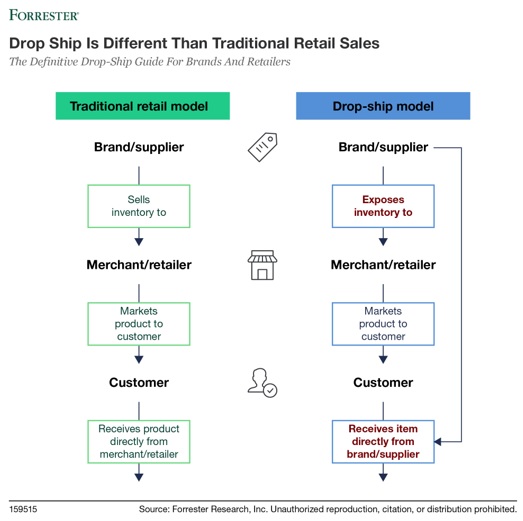
An unsung hero has emerged to help save us from the challenges of closing stores and stocked-out shelves: drop shipping. To be clear, it’s hardly new for retailers to offer items for sale without actually stocking them, so that suppliers can “drop ship” the items directly to consumers. But savvy retailers and brands this year see its potential for so much more to capitalize on forever-changed consumer expectations. And retailers and brand professionals are interested: at Forrester, more than half we surveyed this year already have a drop-ship program in place or plan to implement one within the next few years.
So, if drop shipping is nothing new, why is it becoming so prominent now?
-This model allows merchants to sell from more places, because they can drop ship digital orders from dark stores or directly from suppliers.
– It lets merchants and suppliers sell to more places as well. Retailers and marketplaces accept items on their websites regardless of whether the products won a spot on physical retail shelves.
– Retail is breaking down the walls between isolated selling channels to find every sales opportunity. Because this shrinks the distance between supplier and consumer, it protects margins, reduces lead times, and exposes more inventory to more shoppers.
How does drop shipping differ from traditional retail?
-Rather than selecting, purchasing, and stocking items to sell to customers, retailers instead select from available items that suppliers have on hand.
-Those suppliers retain ownership of the goods, while the retailer offers them for sale online.
-When a customer buys, the supplier “drop ships” the items directly to the customer, bypassing the retailer entirely.
-The customer still belongs to the retailer, and there are numerous nuances to the division of responsibility between retailers and suppliers.
 Will digital sales continue to grow?
Will digital sales continue to grow?
-Our forecasts show that online (non-grocery) retail will grow by about 17% this year, versus a decline of about 6% for overall (non-grocery) retail sales.
– This is true even though many sales will fall back to physical stores when possible – and consumers have told us they’re looking forward to shopping in-person again. So although the digital boon that the pandemic forced was not forever, digital sales will continue to grow.
How are retailers that already have drop-ship programs evolving them now?
– Beyond the basic “endless aisle,” retailers recognize that expanded assortment leads to expanded sales and they are building out their online catalogs to support that growth.
– These retailers are now looking beyond offering the full catalogs from their known suppliers, and introducing completely new, adjacent categories and experimental lines to their digital shelves.
Where do retailers find the greatest rewards from drop shipping?
– For starters, drop shipping items is often much more profitable for retailers. With all inventory risk, storage fees, and fulfillment operations falling to suppliers, retailers get to capture the sale and outsource the rest.
– This medium lends itself perfectly to testing. Adding product is relatively low-risk and low-commitment, and retailers test new suppliers – and product lines – this way, potentially before deciding whether to risk store shelf real estate on them.
– It’s fast. Because suppliers make these goods available from existing inventory and usually provide all product content and media assets up front, retailers can often onboard new items in a matter of weeks.
How does drop shipping benefit brands?
– Drop shipping opens new opportunities for brands to gain exposure to more shoppers in more channels.
– It also provides greater adoption of their deeper product catalog because, again, retailers are simply willing to try riskier items online.
– Finally, with instant sales data coming directly to brands as items sell through these drop-ship channels, they have access to trends and buying habits where they’ve formerly been in the dark, wholly reliant on retailers to toss them scraps of information about their product performance, promotional status, or sales trends.
What specialized tech is needed to fuel drop shipping?
– There are a few key types of data that must flow between drop-ship suppliers and retail websites to power drop shipping. Suppliers send product data to retailers to populate product details online. Suppliers’ systems frequently update Inventory data so retailers always have an accurate view of item availability, even as suppliers are simultaneously selling on many channels. Finally, order data moves from retailers to suppliers for fulfillment, with shipping information and order status returning.
– You may already have systems in place to handle much of this data movement, such as PIMs (product information management systems), and OMS (order management systems). However, there are specialized connection brokers that streamline the integration between retail/marketplace websites and brands/suppliers. They create a single point of contact to which businesses integrate and enable swift onboarding of new partners and streamlined management as the business scales.
Only through invention… and reinvention… will companies continue to win the business of consumers. Retailers and brands are carrying this lesson forward as they plan for Q4 and next year. There will always be surprises but implementing drop-ship programs now establishes a diversified, long-term strategy that builds new stability and agility into businesses through whatever may come.







































